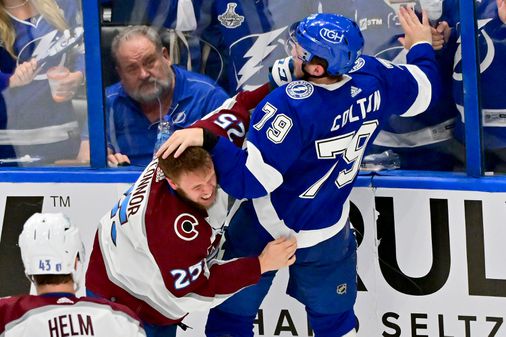“They can scratch my name off that [Stanley] Cup, and I’d hand my ring back right now if I could go back and make it so that I wouldn’t have had to experience all this pain and sorrow and anger and sadness,” he wrote in an essay for the Players Tribune . “I’d make that tradeoff in a heartbeat.”
Former NHL defenseman Nick Boynton was known as an enforcer on the ice for his fearsome style of play. In 11 seasons , he won a Stanley Cup title, totaled 862 penalty minutes , and 51 fights . He also suffered from at least 10 concussions. The repetitive head trauma led to memory loss, anxiety, depression, and addiction.
Advertisement
Hockey is a sport of extremes: graceful on the one hand and violent on the other. The modern game is played with extraordinary power, speed, and skill. There isn’t a more exciting game on the planet.
Get Weekend Reads from Ideas A weekly newsletter from the Boston Globe Ideas section, forged at the intersection of ‘what if’ and ‘why not.’ Enter Email Sign Up
However, those of us in the medical community involved in the sport need to stop skating away from our responsibility to improve player safety.
As a team doctor for USA Hockey and a professor of orthopedic surgery, I have seen firsthand how a career spent fighting can dramatically alter a player’s quality of life long before they reach their fifth decade.
Players often need treatment for hand fractures, oculofacial trauma, and concussions. And there is growing evidence that repeated blows to the head can cause chronic traumatic encephalopathy. CTE is a degenerative brain disease that is associated with a range of symptoms — from depression, aggression, and memory loss to dementia, speech abnormalities, and parkinsonism. In most cases, symptoms appear years after the brain trauma, well after players retire.
In 2018, the NHL settled out of court with more than 300 former players for its failure to do more to prevent head trauma during their careers. But the settlements are a temporary Band-Aid on a larger problem.
Advertisement
Fighting is a serious health risk, and orthopedic surgeons, sports medicine physicians, neurologists, and physiatrists need to be a united front in speaking out about the dangers that result from hits to the head.
Moreover, it is imperative that the NHL makes a rule change: Fighting must be a game misconduct penalty. Fight in the last 10 minutes of a game? You miss the next game, too. To the penalty box after a fight? No, to the locker room for a concussion evaluation. Furthermore, the penalty should be proportionate to the number of fights, so repeat offenders get harsher suspensions.
Making fighting a game misconduct penalty is not going to be easy. Hockey culture is traditionally a warrior culture, complete with a code. There is a vested respect for the way the sport has been played. The NHL “old guard” argues that the rule change would result in decreased viewership and game attendance. Many players and coaches say fighting is a valuable tactic to help win games; that if a team is losing, a fight will switch the momentum to their side.
These are dangerous myths, and my research with colleagues proves it. In three studies this year, we examined the impact of fighting in the NHL.
We found that despite two decades of declines in fighting rates, the popularity of the game has remained unchanged. During the peak of the enforcer era of ice hockey in 1987, there were on average 1.3 fights per game. In the season before the COVID-19 pandemic, the rate was down to 0.19 fights per game. Meanwhile, NHL arenas have been near capacity and were averaging over 17,000 fans a night.
Advertisement
The notion that fighting helps teams win is also false. Look no further than last year’s NHL playoffs. There were 89 games played during the playoffs with a total of 9 fights (0.10 fights per game). A fight between Tampa Bay Lightning’s Ross Colton and Colorado Avalanche’s Logan O’Connor was the first fight in a Stanley Cup finals game since the 2017 postseason. Since the NHL Expansion in 1967, only two teams have led the league in fighting and won the Stanley Cup — the Philadelphia Flyers in 1975 and the Anaheim Ducks in 2007. Clearly, there is little correlation between fighting and a team’s winning record.
While the NHL did make rule changes to prevent concussions in 2011 — an amendment to the rulebook (Rule 48.1) made any hit to the head a penalty — the changes fall short of what is needed. Fighting is already a game misconduct penalty in International Ice Hockey Federation play, the Olympics, NCAA, and many European professional leagues.
Advertisement
The NHL should follow the example set by these organizations. Player safety should be at the forefront of the league’s agenda, and it should immediately change the rule. It’s a worthwhile investment in the players and the long-term health and viability of the game.
Dr. Charles A. Popkin is an orthopedic surgeon and sports medicine specialist in the Department of Orthopedic Surgery at New York-Presbyterian/Columbia University Irving Medical Center and an associate professor of orthopedic surgery at Columbia University Irving Medical Center. He also serves as a team physician for USA Hockey and is a member of the USA Hockey National Safety and Protective Equipment Committee.


